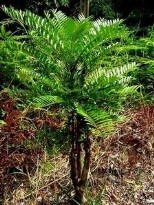Tongkat Ali
| Tongkat Ali | |
| Scientific name | Eurycoma longifolia Jack |
| Common Name | Pasak bumi (Indonesia) |
| Synonyms | Pasak bumi (Indonesia) |
| Family | Simaroubaceae |
| Plant Material of Interest | Root |
 |
{slider=General Appearance}
Tall slender shrub tree.Leaves are up to 100cm with leaflets lance-shaped. Fruit is 10-17 mm x 5-12mm (1)
{/slider}
{slider=Geographical & Distribution}
Sandy soil in Southeast Asia. Peninsular Malaysia, Thailand, Sumatra, Myanmar, Laos, Vietnam, Philippines
{/slider}
{slider=Chemical Constituents}
Root contains: quassinoids, squalene derivatives, biphenylneolignans, tirucallane type trtertpenes, canthine-6-one and β-carboline alkaloid.
{/slider}
{slider=Traditional Uses}
The roots of this plant used to alleviate various diseases such as malaria, dysentery, glandular swelling, and sexual insufficiently. In Malaysia, the plants ere used to improve strength and power during sexual prowess
{/slider}
{slider=Pharmacology}
Initiation of sexual performance E. longifolia Jack promoted the growth of both ventral prostate and seminal vesicles as compared with control, The study showed that the plant as an aphrodiasiac (Ang H.H et al 2000)
Anti Malaria Four quassinoids, eurycomanone (1), 13,21-dihydroeurycomanone (3), 13α(21)-epoxyeurycomanone (4), eurycomalactone (6) and an alkaloid, 9-methoxycanthin-6-one (7), displayed higher antiplasmodial activity against Gombak A isolate but were less active against the D10 strain when compared with chloroquine. Amongst the compounds tested, 1 and 3 showed higher selectivity indices obtained for the cytotoxicity to antiplasmodial activity ratio than 14,15β-dihydroxyklaineanone (2), eurycomanol (5), 6 and 7 (Chan KL et al 2004).
Antioxidant The DPPH assay showed significant antioxidant activity in all concentrations (10, 25, 50,100 and 250 µg/mL). The antioxidant property of the extract was compare with the values of ascobic acid. The extarct showed a significant anti-inflammatory activity in all the concentrations tested (25, 50, 100, 250,100 and 1000 µg/ml). (Varghese C.P. et al 2012).
Cytotoxic E. longifolia extract and its fractions exert a direct antiproliferative activity on human breast cencer cell line MCF-7) (Tee T.T. & H.LP Azimahtol 2005).
Antibacterial The alcoholic and acetone extracts from leaves and stem extracts were active on both Grampositive and Gram negative bacteria (Faroul A. & A. Benafri 2007).
Toxicity
Neither mutagenicity nor clastogenicity was noted and acute oral LD50 was more than 6 g/kg bw/day). Adverse effects attributable to test compound were not observed with respect to body weight, hematology, serum biochemistry, urinalysis, macropathology, or histopathology. The calculated acceptable daily intake (ADI) was up to 1.2 g/adulat/day (Chiang H.L. et al 2013).
{/slider}
{slider=References}
Thi Van Anh Tran, Clemens Malainer, Stefan Schwaiger, Atanas G. Atanasov, Elke H. Heiss, Verena M. Dirsh & Hermann Stuppner (2014 ). NF-KB Inhibitors from Eurycoma longifolia. Journal of Natural Products (77). 483-488.
Hooi Hoon Ang, H.S.Cheang & A. P. Md Yusof (2000). Effects of Eurycoma longifolia Jack (Tongkat Ali) on the Initiation of Sexual Performance of Inexperienced Castrated Male Rats. Exp. Anim 49 (1) 35-38.
Chan K.L , C.Y. Choo, Abdullah N.R. & Ismail Z. (2004). Antiplasmodial studies of Eurycoma longifolia Jack using the lactate dehydrogenase assay of Plasmodium falciparum (2004). Journal of Ethnopharmacology Vol 92 (2-3) Pg 223-227).
Varghese C.P. , C. Ambrose, S.C. Jin, Y.J. Lim & T. Keisaban (2012). Antioxidant and Anti-inflammatory Activity of Eurycoma Longifolia Jack, A Traditional Medicinal Plant in Malaysia. International Journal of Pharmaceutical Sciences and Nanotechnology Vol 5 (4).
Tee TT & H.L.P. Azimahtol (2005). Induction of Apoptosis by Eurycoma longifolia Jack Extracts. Anticancer Research 25; 220502214.
Farouk A. A. Benafri (2007). Antibacterial activity of Eurycoma longifolia Jack. A Malaysian medicinal plant http://smj.psmmc.med.sa/index.php/smj/article/viewFile/5971/3745
Chiang Hao Li, J. W. Liao, P L. Liao, W.K. Huang, L.S. Tse, C.H. Lin, Jaw J. Kang & Y.W. Cheng (2013) Evaluation of Acute 13- Week Subchronic Toxicity and Genotoxicity of the Powdered Root of Tongkat Ali (Eurycoma longifolia Jack). Evidence based Complementary and Alternative Medicine http://www.hindawi.com/journals/ecam/2013/102987/
http://www.globinmed.com/index.php?option=com_content&view=article&id=62689:eurycoma-longifolia&catid=369: (1).
{/slider}
- Last updated on .
- Hits: 4220
